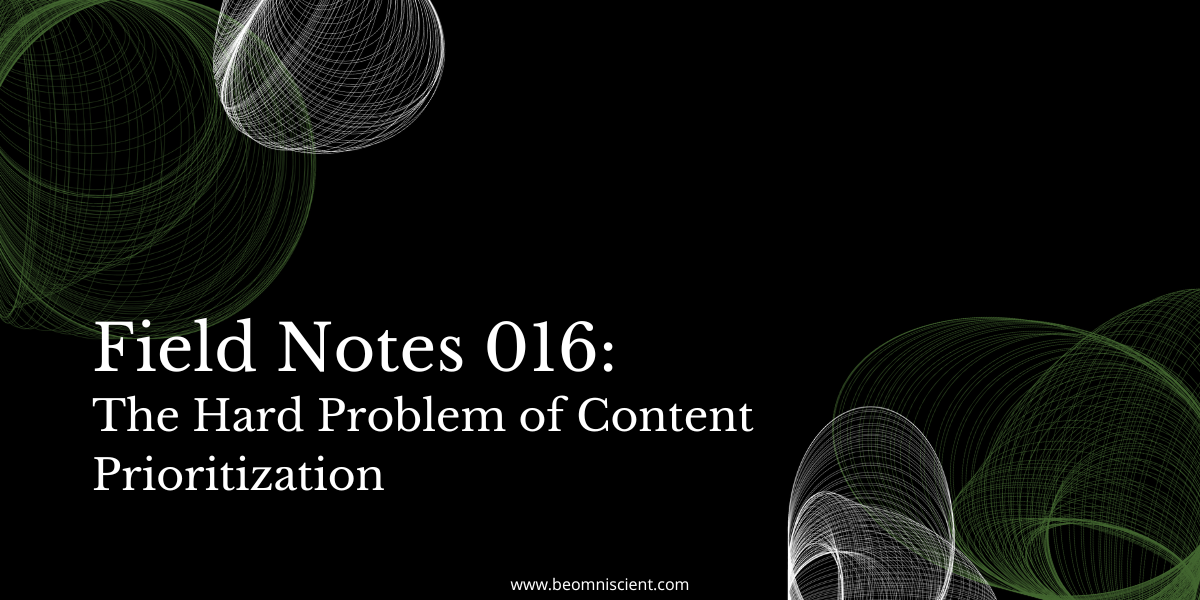
Many prospects and clients have asked, “how do you prioritize the content roadmap?”
I always sort of squirm and give a half answer around “working backwards from your goals and then choosing the highest impact actions,” but if I’m being honest, I haven’t come up with a documented prioritization process.
…which is weird.
See, my background is largely in growth & experimentation. In this discipline, prioritization is a HUGE deal. You’re dealing with limited resources and large opportunity costs.
But guess where else you’re dealing with limited resources and large opportunity costs? Content!
So why don’t we have a good content prioritization framework?
I’ll tell you: it’s hard. There are three big challenges with developing a holistic prioritization framework for content marketing, which I’ll get to in a minute.
First, a bit of background on existing prioritization models for product management, growth, experimentation, etc.
All of them, at the end of the day, are trying to maximize “expected value,” which is “a predicted value of a variable, calculated as the sum of all possible values each multiplied by the probability of its occurrence.”
The two main inputs for expected value are “cost” and “predicted reward,” and the predicted reward can further be broken down into the estimated payout and the probability of that payout.
So if it costs you $1 to pull a lever with a 10% chance of winning $10, the expected value is essentially breakeven (10% of $10 is $1, which is what it costs to pull the lever).
Again, EV = [Probability of winning * What you win] + [Probability of losing * What you lose]
Here, EV = [10% * $10] + [100% * -$1] = $0.
Digression over, this is why the main frameworks for prioritization include a) cost (ease) b) impact and c) confidence (probability):
All of these are models, and theoretical frameworks where we use inputs to predict desired outputs.
So why is it so hard to build a prioritization model for content?
- The complexity of our various content marketing goals
- The supporting role of content marketing in other teams and initiatives
- Multiscalar differences in prioritization importance
First, content marketing goals are almost always multi-faceted. This is one reason we try to simplify goals into a sort of Overall Evaluation Criterion. If you’re aimed at several different targets, it’s hard to prioritize actions let alone hit each of those goals.
Second, content is almost always useful as a supporting function in addition to a centralized effort. For instance, content can support sales cycles, retention, social media, and integrated marketing campaigns. It’s hard to place a predicted value on these, let alone compare predicted values across teams and domains.
Finally, content planning is multiscalar. What matters at the level of an individual keyword (volume, difficulty, intent) doesn’t matter as much at the level of a campaign or cluster (customer demand, strategic importance, market trends).
So it’s a hard problem, and I’m working on a model at this very moment.
In the meantime, keep these things in mind when you prioritize content initiatives:
- Prioritize both at the campaign/cluster level as well as the atomized/individual piece level (and perhaps use different models for each).
- Get crystal clear on your KPIs and make sure they’re actually indicative of success at a program level. If overall traffic is the goal, clearly sales enablement content is going to be deprioritized (but vice versa if assisted revenue is the goal).
- When possible, get objective and binary inputs into your model. For example “Did this piece come from customer feedback?” Or “How much monthly traffic do we expect from this piece?”
- Consider prioritizing underrated dimensions. Everyone can and does prioritize by search volume. What if you were able to pick “ease” and publish at 5-10X the pace? That could be a strategic advantage provoked solely by your prioritization model. Prioritization is inherently strategic, not a universally applicable science.
- Keep perhaps 20% of your resources and planning open for buffer space (things like last-minute additions, campaigns for trending topics, or lag time/delays on planned initiatives).
Recommended Reads
1. The traditional content funnel doesn’t exist – loved this LinkedIn post by Irina Maltseva. The idea that a prospect ALWAYS first clicks on your “what is X” piece, then goes to your “how to do X” piece, and finally purchases on your “best X tools” piece is stupid. Treat every touchpoint like it might be the only one, at least as a baseline heuristic from which to experiment.
2. Your team is wrong about what it can get done – Benyamin Elias writes about, essentially, limiting beliefs and the power of audacious projects with loose specifications to shatter them.
3. The case for content quantity – Jakub Rudnik’s LinkedIn takes have been excellent lately, and this one is just gold. He makes the case for shots on goal, AKA increasing content output. No one is arguing for poor-quality content; we’re just making excuses not to be publishing as much as we should be.



